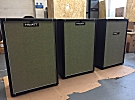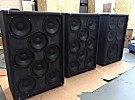The Return of Hiwatt
Posted on 21/10/2018 by ozzy in Amps

Starting 2017, the Us+Them tour witnessed an unexpected return of Hiwatt amps to the Roger Waters bass rig. He employed a pair of Hiwatt Custom 200 - DR201 bass amps. Along with two speaker cabinets: one Hiwatt 8x10 cabinet "SE810C/F" custom built for Roger, the other cabinet was a Hiwatt Full Range cabinet 4x10 + 1x15 "SE115410F".
Source: Hiwatt UK
Posted in Amps | Please leave your comment
Gus Seyfert's black Fender Stratocaster
Posted on 19/09/2018 by ozzy in Guitars

During the Us and Them tour (2017-2018) Roger Waters used a never-seen-before Fender Stratocaster with a black worn-out body, rosewood fingerbord, and small headstock. This guitar was borrowed from Gus Seyfert, the guitarist who toured with Roger and had worked on his Is This The Life We Really Want album. The Gus' Strat was played in Welcome to the Machine.
Posted in Guitars | Please leave your comment
Alembic F-2B preamp (DIY)
Posted on 19/09/2017 by ozzy in Amps, The Blog
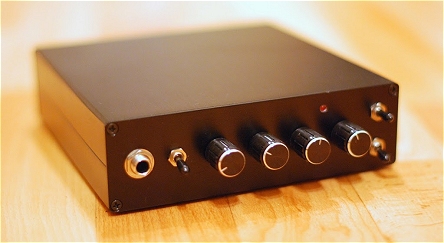
The Alembic F-2B preamp is often referred as the secret ingredient of David Gilmour's tone. But it was originally meant for improving Roger's bass rig. It's a straight up copy of preamp section of a Fender Dual Showman, which is a copy of the basic circuit found in a RCA Receiving Tube Manual from 1948!
These preamps are still available, even today, but they don't come cheap. If you are after the original unit, be prepared to pay about $1,500.
The good news is that the same preamp can be purchased for much less than that. Just go to FrogPedals.com and look for the Frog Tube Preamp. You have two buying options there: a) complete Frog Tube Preamp Fx1 unit, or b) DIY printed circuit board (PCB) to make your own preamp.
As you can see on the pictures, my build is PCB based and has some additional improvements - such as hi-cut switch, two switchable clipping diode pairs (Germanium and Silicon), and optional 6/12V tube heater switch. It's powered by standard 9V DC power supply - 9 volts DC is pumped up to a 185+ volts DC which is supplied to the standard tube amp circuitry for Class A operation.
It provides a clean sound with a nice vintage feel, and handles all my pedals perfectly.
Posted in Amps, The Blog | Please leave your comment
How to build your own Klon Centaur (DIY)
Posted on 15/03/2017 by ozzy in The Blog
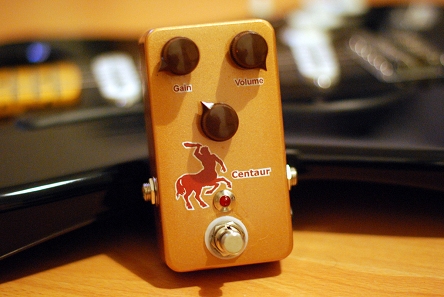
A short while ago, I had written not very favorable review about the Soul Food (see my review here). The Soul Food was an Electro-Harmonix' take on the famous Klon Centaur overdrive, and to me it was a huge dissapointment. I really couldn't understand, why everyone was so excited about it.
I eventually ended up selling the Soul Food and obtaining the real thing. But my Klon is not the Klon per se. It's a clone of the Klon. And the best part of the story is that I have built it myself!
I am not trying to show off here. What I am trying to say is that building your own effect pedal of the boutique quality is fairly easy. If you happen to have basic soldering skill, you are good to go.
The whole design of Klon Centaur has already been reverse-ingeneered a while ago, so its exact schematic is no secret anymore. The secret are the specs of clipping diodes used to achieve the required tone character. People have tried all sorts of diodes in the circuit, and found that the Russian D9E diode was an exact tonal match. Luckily, these diodes are still being sold on eBay. The other parts of the build are pretty common and could be sourced from almost anywhere.
I recommend to purchase the PCB (Printed Circuit Board) from AionElectronics.com. The Refractor project found there is a straight-up replica of the Klon Centaur. Check the project's documentation for more info. It helps to bust a few myths and clear up some misconceptions too. Highly recommended!
How to get started:
If you are a beginner, you may find these tips useful.
1. Get a basic tools
Absolutelly necessary: soldering iron with holder & sponge, soldering iron tip cleaner, solder, wire cutters, wire
Will make your life much easier: good reading lamp, third hand, wire stripper, tweezers, half-round-nose pliers, desolder pump or solder remover
Only needed if you want to go serious: digital multimeter (DMM)
2. PCB
I'd recommend getting your PCB from AionElectronics.com. All projects of this guy are very well documented and therefore most suitable for the beginners.
3. Common parts and components
Nothing fancy here. Just check the documentation and purchase all needed parts. If you are having trouble of sourcing them localy, try TaydaElectronics.com. This e-shop is fucused on the electronics hobbyists and pedal builders, and their rates won't dissapoint you. (Also be sure to check their Facebook page regullary for the 15% discount code!)
4. The "magic" diodes
I got my pair of D9Es at eBay (a Bulgarian stock). You shouldn't be worried doing the same.
5. Soldering
Watch a soldering lessons on Youtube. Soldering is really not that difficult and with some practice it will become your second nature.
6. Goodl luck!
Useful links
Madbeanpedals.com/Forum/ - place where to get some help
FreeStompboxes.org - forum
Madbeanpedals.com - PCBs
AionElectronics.com - PCBs
TaydaElectronics.com - great parts source for electronics hobbyists
Basic Soldering video-lessons - Youtube lessons
Posted in The Blog | Please leave your comment
EHX Octave Multiplexer (DIY)
Posted on 04/03/2017 by ozzy in The Blog
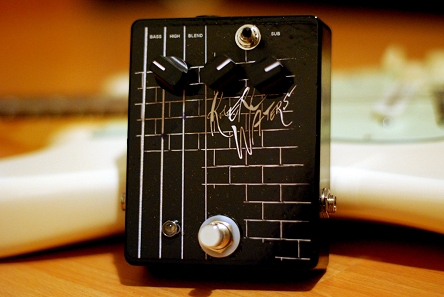
Just thought that I could share my take on the classic Electro-Harmonix effect pedal that I have built from the layout found on the Guitar FX Layouts web site.
The vintage EHX Octave Multiplexer pedal generates deep bass tones, one octave below the notes you play on your normal guitar. It comes handy when you need to play just a few bass lines here and there.
Obviously, the pedal enclosure design was inspired by Roger Waters Signature Fender Precision Bass.
Posted in The Blog | Please leave your comment
Squier P-Bass Special Edition
Posted on 15/01/2017 by ozzy in Basses

The black Squier Precision Bass first appeared on Roger Waters FB profile in January 2017. Judging from the picture below, Roger played it when he was in studio recording his new album. It's hard to tell if he used it on any particular track, or if he was playing it only because at the moment there wasn't any other bass around.
Fender introduced this fairly inexpensive instrument in 2007 as Squier P-Bass Special Edition. The very first thing that attracts attention is its black glossy finish, accentuated by the chrome hardware and mirror pickguard.
This bass featured an agathis body with a maple C-shaped Jazz Bass neck, the rosewood fretboard with 20 medium-jumbo frets and a 9-1/2" radius.
A split single-coil pickup in the center and a Jazz Bass pickup in the bridge were added for tonal versatility. The both pickups had its own volume control.
Posted in Basses | Please leave your comment
The David Gilmour's Hendrix guitar strap
Posted on 05/07/2015 by ozzy in The Blog

This cross-stitched chocolate suede guitar strap in question has perhaps become as famous as its owner's black stratocaster. This strap was owned by Jimi Hendrix, and in 2006, it had been given to David by his wife Polly Samson. From that point on, we, Gilmour fans, had wanted to own such strap, too.
The first guitar strap manufacturer who seized the opportunity here was Jeri designs. Their replica looks beautiful, but the price is insane. So I did a small research to see, what other manufacturers have to offer. Soon, I had found that most of their copies were surprisingly lame. Some of the manufacturers simply din't bother to copy it properly. Either colour, or shape, or both were wrong. Wouldn't it be cross-stitched, you perhaps wouldn't recognize the strap at all.
Finaly, certain Greek manufacturer Paul Minotaur got the design adequately right. And the price seems to be within the reason, too.
The only drawback is that their strap should be a lot more flexible on its length adjustment. And another issue is that it doesn't look very secure to use. It takes just one(!) cap rivet to keep everything together, and I have absolutely no doubt about what will happen, if I jump on stage too much. If you need to shorten your strap a lot more to ensure the best playing position, you will have to plant another rivet in it. I also recommend replacing the leather end of the strap (the end where strap button goes) for something made of a material you can trust. Applying a buckle-like-something that will prevent your strap to go loose whenever the rivet fails, won't hurt either. I wouldn't dare gigging with my priceless Strat like that before I do the above.
Here folows the break down of a Gilmour Hendrix straps available on the market at the time of writing this:
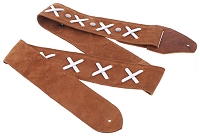 « 1) Paul
Minotaur / The Legend
« 1) Paul
Minotaur / The Legend
Price: $66 (59 EUR)
 2) Jeri
designs / Replica Price: $250
2) Jeri
designs / Replica Price: $250
 « 3) Jeri
designs / Modified
« 3) Jeri
designs / Modified
Price: $99
 « 4) Tundra
Leather Price: N/A
« 4) Tundra
Leather Price: N/A
 » 5) Dave
Brown / Another design inspired by Jimi's strap by Minotaur
» 5) Dave
Brown / Another design inspired by Jimi's strap by Minotaur
Price:
38 USD (34 EUR)
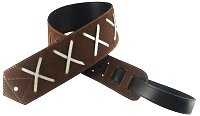 « 6) Basso
straps / DG-02
« 6) Basso
straps / DG-02
Price: $16 (R$ 45,90)
 7) Martin
Pryce Leather / Gilmour replica strap
7) Martin
Pryce Leather / Gilmour replica strap
Price: $120 (79 GBP)
Posted in The Blog | Please leave your comment
Andy Summers' rig on BUDGET (The Police years)
Posted on 29/05/2015 by ozzy in Summers-ish
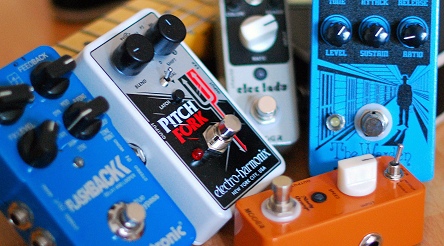
Continues from Andy Summers' rig (The Police years), part I
How to come close to Andy Summers tone without buying expensive equipment.
Amplifier
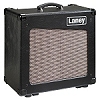
A low-priced tube Marshall amp won't deliver the tone of a Marshall JMP that you are after. In fact, it won't deliver a decent tone at all. The CUB series by Laney offers a range of a nice low-wattage clean sounding combos with slightly marshallish character. Available are the 5, 10 and 15-Watt tube models, and one 15-Watt amp head with a matching cabinet. Highly recommended!
Guitar
 Squier Telecaster Custom would be a good starting point for your
own take on the famous Fender Telecaster Custom of Andy Summers. You
might find handful of ideas in the article Squier
Andy Summers Tribute Telecaster project.
Squier Telecaster Custom would be a good starting point for your
own take on the famous Fender Telecaster Custom of Andy Summers. You
might find handful of ideas in the article Squier
Andy Summers Tribute Telecaster project.
However, if you want to stay on the safe side, it will be much better to follow Andy's red 61' Fender Stratocaster. You will only need a Squier Classic Vibe '60s Stratocaster, or MIM Standard Strat, with rosewood fingerboard. Its stock pickups should be replaced with the period-correct Fender 57/62 pickups.
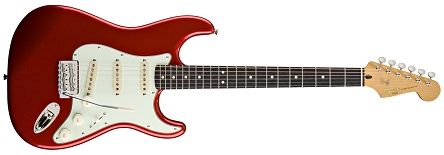
Effects
 MXR Dyna Comp
MXR Dyna Comp
Type: Compressor
A quite nice compressor based on the classic Ross circuit. The vintage "script logo" reissue has a nice smooth tone, but can only be powered by battery and costs twice as much as a the cheaper "box logo" model.
FYI: I personaly use the Warden by EarthQuaker Devices, which seems to work very well. It's clean, neutral sounding compressor with studio-style controls and features. And it's deadly silent, too.
 Mooer Ninety Orange
Mooer Ninety Orange
Type: Phaser
Mooer Ninety Orange is a copy of the MXR Phase 90, produced by now popular chinese manufacturer. It might be less smooth sounding than a "script logo" original, but still an excellent alternative for people on tight budget.
 Mooer Eleclady
Mooer Eleclady
Type: Flanger
Although this pedal doesn't work with distortion as good as the original, it's considered to be the best sounding clone of the Electric Mistress available. Very Summersish and highly recommended!
 EHX Micro Q-tron
EHX Micro Q-tron
Type: Envelope follower
The Q-tron was designed for the EHX by Mike Beigel, the inventor of the Mu-tron III and former owner of Musitronics Corp. By using the same analog circuitry as the original, he managed to keep the sound as close to it as possible.
 MXR Distortion+, EHX Bass Big Muff Pi
MXR Distortion+, EHX Bass Big Muff Pi
Type: Fuzz / Distortion / Overdrive
In my opinion, there is no great sounding budget Muff on market. Fortunately, Andy's tone isn't based on that at all. However, if you really need to own one, try the Electro Harmonix Bass Big Muff Pi.
The MXR Distortion+ or any similary sounsding dirt pedal set to mild overdrive will suffice. Most of a budget clones will do equaly well, too. You even might want to use a boost pedal to simmulate the mid-boost circuit built in Andy's Telecaster. (The solo in So Lonely, for example, uses both pickups out-of-phase plus the on-board booster.)
FYI: As for me, my Xotic SL Drive works perfectly for Andy's overdriven tones. It faithfully delivers sounds of the Marshall Super Lead and Super Bass amps. But it doesn't come cheap, of course.
 EHX Memory Toy
EHX Memory Toy
Type: Delay
The Memory Toy is a nice sounding analog delay that won't cost you a fortune. However, if you want to go serious, get an excelent TC Electronic Flashback, Flashback X4, or Nova Delay. They are reasonably priced and offer a simmulation of various types of delay, such as "tape" and "analog". (Andy have used the Flashback in his Circa Zero pedal board.)
 EHX Pitch Fork
EHX Pitch Fork
Type: Pitch Shifter, Guitar Synth substitution
Rather than to buy a second-hand Roland guitar synth on eBay, you might want to combine a pitch shifter with flanger and delay. Set the pitch shifter to the 5ths, play "strange" chords, and you may get close to the synth sound you are after. Don't forget fidling with the tone (yes, the tone!) knob on your guitar, too.
FYI: I use the EHX Pitch Fork in conjunction with the Eleclady and Flashback. The result is very, very convincing.
 Danelectro Tuna Melt
Danelectro Tuna Melt
Type: Tremolo
Originally, back in the 70s/80s, Andy haven't used tremolo effect at all. It hadn't become part of his rig until the Police reunion tour in 2007 (see Andy’s Reunion Tour rig). He emloyed the Empress Tremolo on stage to create deep tremolo effect in Walking in Your Footsteps. The Empress Tremolo is an excellent pedal, but definitely not a budget one, so if cost is the issue you will have to look elsewhere.
The Boss TR-2 Temolo is perhaps most obvious (and safe) choice to go with. However, you may want to check eBay for an extra-cheap, but surprisingly nice and warm sounding Danelectro Tuna Melt, or, sadly, now discontinued, Line 6 Tap Tremolo, featuring a tap tempo function. The Super Pulsar by EHX is a truly creative tool that will satisfy even the most demanding player.
BTW: Think of Gilmour's tremolo in Money, or Roger's in One of These Days.
Posted in Summers-ish | Please leave your comment
Andy Summers' rig (The Police years)
Posted on 16/05/2015 by ozzy in Summers-ish
At the very beginning of the birth of The Police, Andy Summers' rig was rather sparse. To Guitar Player magazine he revealed: “I had simple tools: a Telecaster, a Fender Twin, and maybe an MXR Phase 90. The next thing I got was a chorus, and that, along with the Echoplex, became very characteristic of the Police sound. I probably got up to four pedals taped to the floor before I could afford a custom Pete Cornish pedalboard with a MuTron, a couple of fuzz boxes, an envelope filter, chorus units, and phasers, all of which I’d combine with the Echoplex.”
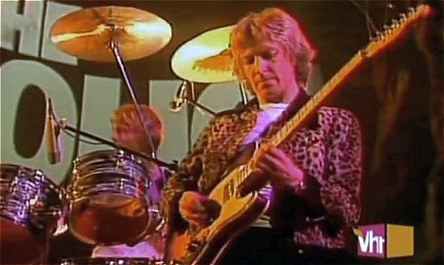
Times have changed though, and so has Andy's equipment: "Onstage I've been using the same set-up for about the last three years," he explained to Musician magazine in 1984, "which is two reworked, souped-up Marshall 100-watt tops, two 4x12 cabinets, (I'm not sure what the speakers are because my faithful roadie changes them all the time). I use them at about half-volume, with not a lot of presence. I also record occasionally with a Bolt amp. I also have a Peter Cornish custom-made pedalboard which contains an MXR Phase 90, an MXR Analog Delay, a Mutron III envelope follower, a fuzz, an Electro-Harmonix flanger and a Dyna-Comp compressor. I carry two Echoplexes on tour, both of which are about fifteen years old. I combine the analog delay and the Echoplex to get some double rhythm effects. The board has a master effects on and off button, so you can pre-program effects together without having any effects on, then just hit one button and have them all come on together."
Amplifier

During the Police years, Andy Summers played two 100-Watt Marshall heads, acquired in the late '70s, with two 4x12 Marshall speaker cabinets. Those amps either could be the Marshall JMP 1959 Super Lead, or 1992 Super Bass. It's hard to tell which of them exactly as they both look the same. The Marshall Super Bass was initially designed for bass players, but many guitarists decided to use them too. They had slightly less gain and were smoother sounding than their Lead counter-parts.
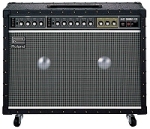 Along with the Marshalls, Andy also used a Roland
Bolt and Roland
JC-120 solid-state amps.
Along with the Marshalls, Andy also used a Roland
Bolt and Roland
JC-120 solid-state amps.
"I like to use two Roland JC-120s, because they’re real clean and hard. They suit guitar synthesizers almost more than the regular." (Guitar Player magazine, 1986)
Guitars
The main guitar of Andy Summers' then, was his old battered, heavily modified Fender 61' Telecaster Custom that he purchased from his student in Los Angeles. The Telecaster was closely followed with the red Fender 61' Stratocaster that seems to be his main guitar today.
The other Andy's guitars include several models of Hamer that he endorsed in the De Do Do Do, De Da Da Da music video, Aria Pro (Next to You, live at the Old Grey Whistle Test) , Guitarman 12-string (Synchronicity I, Synchronicity concert video), Gibson 335 and Les Paul (both Ghost in the Machine album), Roland G-303 guitar, used to control his Roland guitar synth (Don't Stand So Close To Me), and many other guitars. Perhaps too many to mention.
Effects
In 1978, Andy acquired a Pete Cornish custom build pedal board. It contained an MXR Dyna Comp, MXR Distortion+, MXR Phase 90, MXR Analog Delay, EHX Electric Mistress, and Mu-Tron.
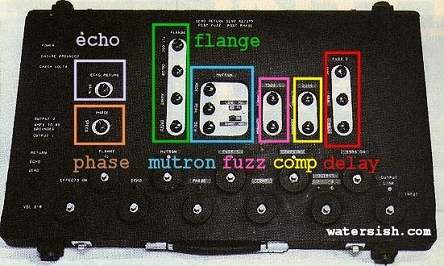
 MXR Dyna Comp
MXR Dyna Comp
Type: Compressor
Songs: Deathwish, Bring on the Night, Message in the Bottle, Walking on the Moon
 MXR Phase 90
MXR Phase 90
Type: Phaser
Songs: Hole in My Life.
Andy's prominent modulation effect on Outlandos d'Amour: "sort of scotch-taped to the floor". Also used by Sting on his bass (live recordings of Shadows in the Rain, Bring on the Night).
 EHX Electric Mistress
EHX Electric Mistress
Type: Flanger
Songs: Walking on the Moon, De Do Do Do, De Da Da Da, Driven to Tears, When the World is Running Down... to name a few.
Althought often mistaken for chorus, the Electric Mistress flanger(!) has always been an essential part of the Police sound.
When Andy used the "real" chorus, he seemingly used a unit built-in the Roland JC-120 solid-state amplifier. (This circuit was later "repacked" into a single pedal, known as a Boss CE-1.)
Another chorus effect Andy Summers acquired was the Boss CE-3: Released in October 1982, Andy had used it soon after, on the Synchronicity concert in Atlanta. Since the CE-3 was just sitting on his pedal board, meaning it wasn't built-in, it can be assumed that he was just trying it out.
 Musitronics Mu-Tron III
Musitronics Mu-Tron III
Type: Envelope follower
Songs: Hungry for You, Flexible Strategies, Every Little Thing She Does is Magic
A touch-controlled funky-sounding effect, easily mistaken for normal wah-wah.
 MXR Distortion+, EHX Big Muff
MXR Distortion+, EHX Big Muff
Type: Fuzz / Distortion / Overdrive
Songs: Fall Out, Next to You, Truth Hits Everybody
In fact, I didn't find any verifiable proof that Andy Summers used any of those. So this is purely based on my, and other people's hearing. Hence subjective. That said, the MXR should have been identified correctly though: "I have an MXR Phase 90, Electro-Harmonix flanger, MXR fuzz, an analog delay, a Mu-tron III, and a compressor." (Guitar Player magazine, 1982)
 MXR Analog Delay + Maestro Echoplex, Roland Space Echo
MXR Analog Delay + Maestro Echoplex, Roland Space Echo
Type: Delay
Songs: Reggatta de Blanc, Deathwish, Can't Stand Loosing You, Tea in the Sahara ...and many more
Delay has always been instrumental for Andy's tones. In Can't Stand Losing You he got a double rhythm effect by using of two Echoplexes. Tea in the Sahara was all done with a Stratocaster and an Echoplex. For a certain period of time, he also used a Roland Space Echo.
 Roland GR-300, GR-100
Roland GR-300, GR-100
Type: Guitar synthesizer
Songs: Don't Stand so Close to Me, Secret Journey, Darkness, Oh My God, I Burn for You, Once Upon a Daydream
By the Regatta de Blanc, Andy acquired a Roland GR-500 guitar synthesizer. The band was working so hard on the road, that he haven’t had a chance to get acquainted with it. Later on, he used Roland GR-300 for a couple of songs, such as Don’t Stand So Close to Me, on Zenyatta Mondatta, as well as for material from the Ghost in the Machine album.
Andy usually used the Echoplex and flanger in conjunction with the synthesizer. To achieve the same effect, which is in the middle of Don’t Stand so Close to Me, he used a "Duet" switch, which adds an extra interval - typicaly the 5th - to any note that's being played. Additionaly, he has being opening and closing the foot-controled filter of the synth, to get the setup working as intended.
In his Police Reunion Tour rig, he replaced his old Roland synth with the Eventide Harmoniser.
Source: Guitar Player magazine, AndySummers.com, ThePolice.com
The article continues in... Andy Summers' rig on BUDGET (The Police years), part II
Posted in Summers-ish | Please leave your comment
Squier Cabronita Telecaster: The treatment with ToneRite
Posted on 22/03/2015 by ozzy in The Blog
I read many positive reviews about Squier Cabronita Telecaster that I have decided to buy one. However, playing it, I hadn't been overly excited with its tone. To my ears, it sounded like a couple of wires attached to a piece of wood strummed with a crumpled newspaper. Really bad!
Later, I replaced Cabronita's maple neck with a rosewood one from my Squier Telecaster Custom to see what will happen (I needed a maple neck for my Squier Andy Summers Tribute Telecaster project anyway). I wasn't surprised that the guitar still sounded like shit, but at the same time the new neck gave it a beautifully long sustain. Interesting, what could be achieved by replacement of the guitar's neck. Well, then it was time to improve Cabronita's overall tone.
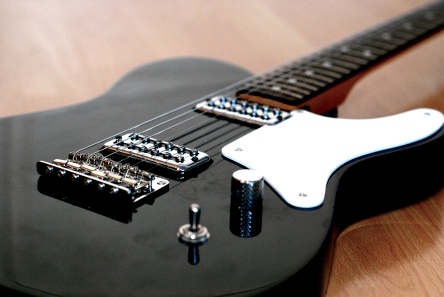
You might have heart about "play-in" simulators. These devices are based on the theory that the more your instrument is played, the faster it reaches its full sound potential. And believe me or not, it works! I tried it myself so based on my own experience. After 100 odd hours on ToneRite simulator, the guitar started showing some musical quality that weren’t there before. Of course, the ToneRite won’t make a poor instrument great, it’s only designed to bring out the best in it. I would definitely recommend it being used for budget instruments, but maybe for others too. Pity that the price of this useful yet somewhat single-purpose device is so "boutique."


